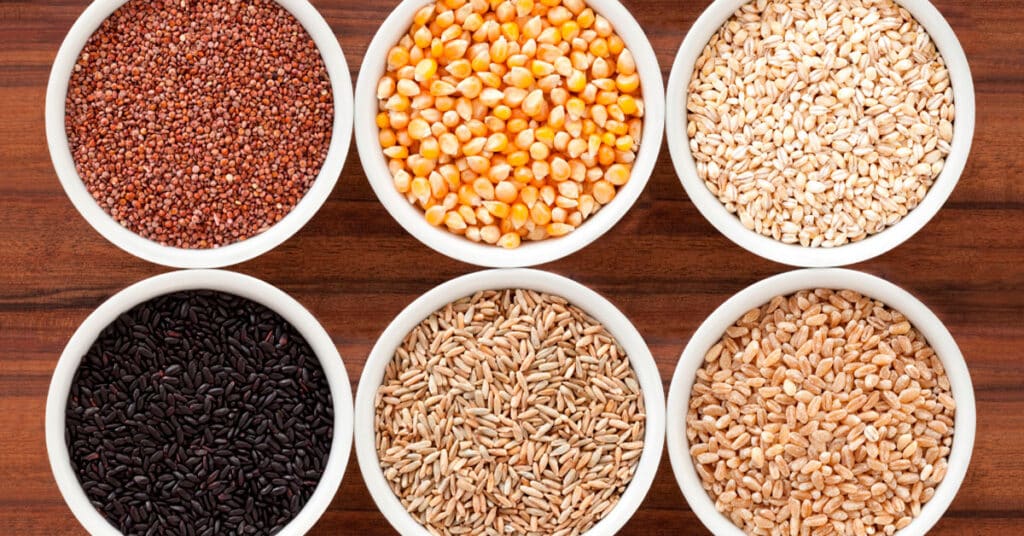

Whole grain foods support good health. Eating whole grain foods reduces the risk of digestive disorders, heart disease, high cholesterol, high blood pressure, type 2 diabetes, obesity and certain cancers. Whole grains are high in complex carbohydrates and fiber that help fill us up and delay hunger. Weight control is made easier by eating more whole grains instead of higher-calorie foods. [1][2]
Composition and Nutrition
Grains are the seeds of plants, and whole grain foods include all three parts:
- Bran – forms the outer layer of the seed and contains fiber, B vitamins, minerals (magnesium, phosphorus, iron, zinc, selenium, copper) and phytochemicals;
- Endosperm – is the kernel and bulk of the seed containing complex carbohydrates, protein and B vitamins;
- Germ – produces the sprout and contains B vitamins (niacin, thiamin, riboflavin), vitamin E, minerals, unsaturated fats, phytochemicals and antioxidants. [1][2]
Other nutrients in whole grains include: tocopherols, beta-carotene, vitamin C, folate, glutamine, phytoestrogens, lignans, flavonoids, oligosaccharides, inositol, phenolics, saponins, lectins, and protease and amylase inhibitors. These nutrients may prevent diseases, lower blood cholesterol, stabilize blood sugar and improve immune function.[1][2]
Fiber is the part of plant-based foods that the body does not digest. Whole grains have both soluble and insoluble fiber. Oats, barley, and rye have soluble fiber that slows stomach emptying and nutrient absorption, reducing the rise in glucose and insulin to improve blood sugar control. Bran has insoluble fiber that adds bulk to stool and shortens transit time through the colon, reducing the time the bowels carry waste products. [1][2]
Refined grains
Refined grains (for example, white rice and white flour) contain only the endosperm and lose up to 80 percent of their nutrients after the bran and germ are removed.[1]
Although vitamins and minerals are added back to most refined grain foods, they have fewer nutrients and less fiber than whole grain foods. Whole grain cereals and breads have three-to-six times more fiber than refined cereals or white bread.[3]
Finding whole grain foods
Read food labels carefully. Whole grain foods are labeled as containing: “100% whole grain” or “whole wheat.” Food is often made mostly of refined grain if it is labeled: “100% wheat,” “cracked wheat,” “multigrain,” “oat bran,” “pumpernickel,” “rye” (breads), “wheat,” “wheatberry,” “stone ground” or “stoned wheat,” “whole bran” (“7-bran,” “12-bran”) or “7-grain” (“9-grain,” “12-grain”).[3]
A food’s color is not helpful in identifying whether it contains whole grains. Dark or brown bread may be a whole grain food or may just have added molasses or caramel food coloring. Alternatively, whole grain foods made from oats or white wheat may be light in color.[3]
Whole grain foods include: amaranth, barley, brown rice, buckwheat, kasha, or buckwheat groats; bulgur (cracked wheat); kamut; millet; oats or oatmeal; popcorn; quinoa; spelt; teff; triticale; whole grain corn or cornmeal; whole wheat; whole rye; and wild rice.[3]
Refined grain foods include: corn flakes, couscous, cream of wheat or rice, crisped rice, degermed cornmeal, enriched macaroni or spaghetti, grits, pretzels, puffed rice or wheat, white breads, and white rice.[3]
Immune reactions
About one in 133 Americans has celiac disease – an inherited, intestinal disorder in which the body cannot tolerate gluten, a protein found in wheat, rye and barley.[4] Corn and rice products made in factories that also make wheat products can be contaminated with wheat gluten.[5] When individuals with celiac disease ingest gluten, their immune system attacks and damages the lining of their small intestine causing malabsorption of nutrients from food. Long-term complications of untreated celiac disease include liver disease, intestinal cancer, and malnutrition that can lead to anemia, osteoporosis and miscarriage.[4] A gluten-free diet is the only treatment for celiac disease.[4]
Wheat allergy is another form of immune reaction against gluten and other wheat proteins. This disorder is characterized by an IgE mediated response resulting in respiratory symptoms or gastrointestinal symptoms.[6]
The majority of individuals seeking medical attention for gastrointestinal symptoms that benefit from gluten withdrawal, however, have non-celiac gluten sensitivity (NCGS).[6] NCGS manifests as intestinal (diarrhea, abdominal discomfort or pain, bloating and flatulence) and/or extraintestinal symptoms (including fatigue, headache, lethargy) that occur after the ingestion of gluten and improve after gluten withdrawal.[6] Symptoms of NCGS overlap with symptoms of the common disorder – irritable bowel syndrome. Whether it is the gluten or the grain that is responsible for these symptoms is unknown. Similarly, whether NCGS belongs to the spectrum of celiac disease with related immunology or to the spectrum of functional bowel disorders caused by other components of wheat is unknown.[6]
Gluten-free whole grain foods
A gluten-free diet means eating no food products made from wheat, rye and barley. This includes most grain, pasta and cereal, and many processed foods. Individuals who wish to avoid gluten can, however, use rice, amaranth, quinoa, or buckwheat flour instead of wheat flour. They can buy gluten-free bread, pasta, and other products. Sometimes oats can be eaten by individuals with celiac disease, but they need to check with their doctor first.[5]
Choose whole grain foods
Whole grains are affordable, can be stored for long periods of time, taste mildly “nutty,” and are easy to prepare. Whole grain foods are low in fat, nutritious and satisfy hunger. Even individuals who wish to avoid gluten can find whole grain foods to fit a healthful, gluten-free diet. Choose whole grain foods instead of refined grains for good health.[3]
References
- Jannalagadda, S, et al. “Putting the Whole Grain Puzzle Together: Health Benefits Associated with Whole Grains – Summary of American Society for Nutrition 2010 Satellite Symposium.” J Nutrition, May 2011, Vol. 141 No. 5:1011S-1022S.
- Slavin J, et al. “Whole Grains: Definition, Dietary Recommendations, and Health Benefits.” Cereal Foods World, July-August 2013, Vol. 58 No. 4:191-198.
- Radke M. “Eat Whole Grains for Health.” NARFE Magazine, September 2007, Vol. 84 No. 9:28-29.
- National Institute of Diabetes and Digestive and Kidney Diseases, National Institutes of Health. http://digestive.niddk.nih.gov/ddiseases/pubs/celiac/
- Radke M. “Is Gluten Making You Sick?” NARFE Magazine, June 2012, Vol. 89 No.6: 24-25. http://issuu.com/narfe/docs/narfe062012
- Nijeboer P., et al. “Non-celiac Gluten Sensitivity. Is it in the Gluten or the Grain?” J Gastrointestin Liver Dis, December 2013, Vol. 22 No. 4: 435-440.
Copyright 2024 Center for Nutrition Studies. All rights reserved.
Earn Your Plant-Based Nutrition Certificate
Join over 20,000 students who have improved their health, learned new skills, and even inspired career changes.
Program Overview
- 23,000+ students
- 100% online, learn at your own pace
- No prerequisites
- Continuing education credits












